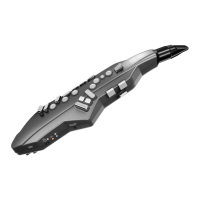
Do you have a question about the Roland Aerophone Go and is the answer not in the manual?
| Type | Digital Wind Instrument |
|---|---|
| Number of Voices | 11 |
| Display | LCD |
| Internal Speakers | Yes |
| Polyphony | 128 voices |
| Bluetooth | Yes |
| USB | Yes (MIDI) |
| Controllers | Breath sensor |
| Connectors | USB |
| Power Supply | AC adapter or batteries |
| Included Accessories | USB cable |
| Key Layout | Saxophone-style |
Protects the reed-style mouthpiece when not in use, ensuring proper fit.
A dedicated mouthpiece with an integrated reed for precise pitch and expression control.
A reedless mouthpiece option offering stable pitch performance.
Keys designed for performance, utilizing standard saxophone fingering patterns.
Left-hand thumb-operated keys to switch octaves and select setting values.
The designated position for the player's left thumb for comfortable grip.
The designated position for the player's right thumb for secure holding.
A button operated by the thumb to bend pitch up or down.
A rotary knob used to select one of the twelve available instrument tones.
Adjusts the base key, determining the actual pitch sounded by the 'C' fingering.
Controls the overall sound volume, complementing breath-based volume.
Details the different USB cable types provided and their specific purposes.
Instructions on how to use the cord hook to securely attach the USB cable.
Guide on how to switch between the reed-style and round-style mouthpieces.
Instructions for correctly wrapping the attached band around the instrument.
Step-by-step guide on how to attach the neck strap to the instrument.
Details on installing and using Ni-MH batteries for powering the unit.
Instructions for connecting and using a USB AC adaptor for continuous power.
How to set the base key using the transpose knob for correct pitch.
Selects the Erhu tone, part of the ethnic instrument sound group.
Selects the Qudi tone, a traditional Chinese wind instrument sound.
Selects the Xiao tone, a Chinese vertical bamboo flute sound.
Selects the Suona tone, a Chinese double-reed woodwind instrument.
Selects the Pipa tone, a Chinese plucked string instrument.
Selects the Matouqin tone, a Mongolian bowed string instrument.
Selects the Yangqin tone, a Chinese hammered dulcimer.
Selects the Guzheng tone, a Chinese plucked zither.
Selects the Hulusi tone, a Chinese gourd flute.
Selects the Banhu tone, a Chinese two-stringed bowed instrument.
Selects the Pan Flute tone, a wind instrument consisting of pipes.
Selects the Shakuhachi tone, a Japanese bamboo flute.
Selects the Tenor Sax tone, a common saxophone sound.
Selects the Flute tone, a common woodwind instrument sound.
Selects the Oboe tone, a double-reed woodwind instrument sound.
Selects the Clarinet tone, a single-reed woodwind instrument sound.
Selects the Bassoon tone, a large woodwind instrument sound.
Selects the Violin tone, a string instrument sound.
Selects the Cello tone, a larger string instrument sound.
Selects the Trumpet tone, a brass instrument sound.
Selects the Harmonica tone, a free-reed wind instrument sound.
Selects the Whistle tone, a simple sound-producing device.
Selects the Accordion tone, a bellows-driven free-reed instrument.
Selects percussion sounds, with fingering assignments detailed later.
Guide on connecting audio output devices to the PHONES/OUTPUT jack.
Adjusts sound characteristics like breath curve, reverb, and fingering types.
Instructions on how to hold the instrument correctly for playing.
Guidance on forming the correct embouchure for the reed-style mouthpiece.
Steps and fingering examples for producing basic sounds.
Sets how breath force affects sound response (e.g., L2, L1, M, H1, H2).
Adjusts the depth of reverberation for a concert hall-like effect.
Selects fingering modes such as Sax, Recorder, or Electronic Wind Instrument.
Overview of features enabled by connecting the Aerophone GO to a smartphone.
Instructions for using the dedicated app to customize Aerophone GO settings.
Connects via Bluetooth to play music from a smartphone through the Aerophone GO.
Utilizes the dedicated app for advanced device customization and sound engine control.
Instructions for cleaning and caring for the instrument's mouthpiece.
Lists key technical details, dimensions, weight, and accessories.
Explains the meaning of warning, caution symbols, and general safety terms.
Covers precautions for placement, volume, disassembly, impact, and environment.
Safety advice for children and detailed handling of batteries.
Guidelines for routing and managing cords and cables to prevent hazards.
Precautions for safe battery use, storage, and procedures for handling leaks.
Safety measures for handling the unit itself, including avoiding pinched fingers.
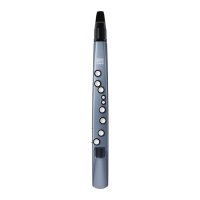
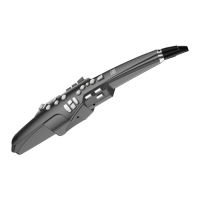
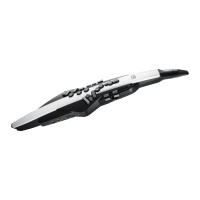
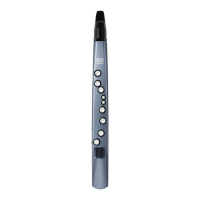
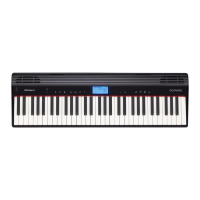
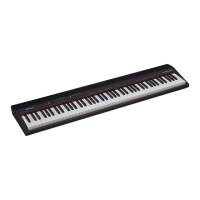
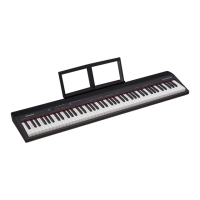
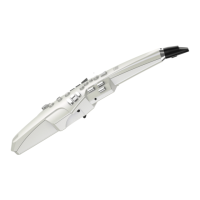
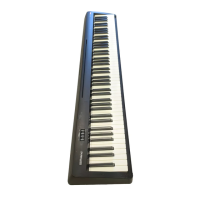

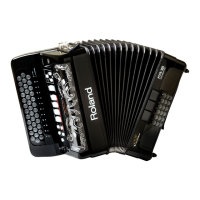
